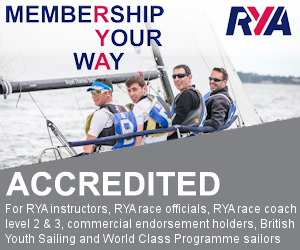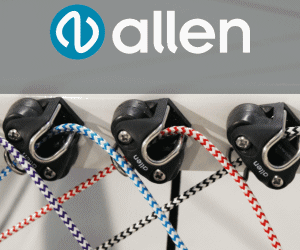-202403121604.gif)







-YandY-202303241230.gif)




Boats for sale
| Laser XD 203301 Upminster |
 |
| Laurent Giles 'Jolly Boat' Exeter |
 |
| J24 (Sail No. 4239) Dartmouth |
 |
List classes of boat for sale |
Leeward Mark Port and Starboard |
Post Reply 
|
| Author | ||
davidyacht 
Really should get out more 
Joined: 29 Mar 05 Online Status: Offline Posts: 1345 |
 Post Options Post Options
 Quote Quote  Reply Reply
 Topic: Leeward Mark Port and Starboard Topic: Leeward Mark Port and StarboardPosted: 11 Aug 14 at 1:26pm |
|
|
This one has caused a fair amount of bar talk, no-one upset but unclear who is right or wrong..
Boat A on starboard gybe, marginal overlap with Boat B Boat B on port gybe Both boats approaching leeward mark on run to be rounded to port Boat A (potentially) in inside position Boat B (outside) enters 3 length circle Boat A calls starboard on Boat B while Boat A is still outside the three length circle If Boat A maintains the overlap it is obvious that she will shortly establish mark room rights, but is Boat A entitled to call starboard in the period before she has entered the 3 length circle? Any one have any thoughts?
|
||
 |
||
jeffers 
Really should get out more 

Joined: 29 Mar 04 Location: United Kingdom Online Status: Offline Posts: 3048 |
 Post Options Post Options
 Quote Quote  Reply Reply
 Posted: 11 Aug 14 at 2:04pm Posted: 11 Aug 14 at 2:04pm |
|
|
In this situation Port/Starboard applies until the closest boat enters the zone at which point Rule 18 takes over and each boat then had different obligations which override port starboard. So as soon as boat B enters the zone rule 18 applies. The outside boat is required to give Mark-Room which is defined as below:
B does have to allow room for A to gybe (rule 18.4) but A (as I understand it) is not allowed to sail out wide and do a 'tactical rounding' they must sail directly towards the mark and is then entitled to proper course at the mark. A certainly should not have been calling starboard once B had entered the zone.
|
||
|
Paul
---------------------- D-Zero GBR 74 |
||
 |
||
JimC 
Really should get out more 

Joined: 17 May 04 Location: United Kingdom Online Status: Offline Posts: 6649 |
 Post Options Post Options
 Quote Quote  Reply Reply
 Posted: 11 Aug 14 at 3:59pm Posted: 11 Aug 14 at 3:59pm |
|
|
Strictly speaking the way the rules are written now they don't over ride port/starboard, they modify it.
So this is my understanding, Brass correct if necessary. Firstly the basic rules Before either boat enters the zone A is ROW boat, and stays ROW boat until she gybes: Rule 10. Once she gybes she becomes windward boat and loses ROW (Rule 11). RRS 15 never applies because B gets ROW because f A's gybe. However Section C may limit he actions of a ROW boat. Rule 18 applies So A is also entitled to mark room as soon as B reaches the zone, but at this point is still ROW boat, but cannot sail anywhere she likes because she is subject to rule 18.4, so she mustn't sail any farther from the mark than required to sail a proper course. Once A gybes she is no longer ROW boat and must sail straight to the mark. The subtlety is in A's proper course. My interpretation of this is that if A is high of the mark and without B there would sail two or three boat lengths past before gybing then she is entitled to do so, because its a valid proper course, and B has to stay clear of the starboard boat. Edited by JimC - 11 Aug 14 at 4:00pm |
||
 |
||
Brass 
Really should get out more 
Joined: 24 Mar 08 Location: Australia Online Status: Offline Posts: 1146 |
 Post Options Post Options
 Quote Quote  Reply Reply
 Posted: 11 Aug 14 at 11:50pm Posted: 11 Aug 14 at 11:50pm |
|
Edited by Brass - 12 Aug 14 at 12:25am |
||
 |
||
Brass 
Really should get out more 
Joined: 24 Mar 08 Location: Australia Online Status: Offline Posts: 1146 |
 Post Options Post Options
 Quote Quote  Reply Reply
 Posted: 12 Aug 14 at 12:21am Posted: 12 Aug 14 at 12:21am |
|
|
||
 |
||
Assassin 
Newbie 
Joined: 24 Jul 14 Online Status: Offline Posts: 25 |
 Post Options Post Options
 Quote Quote  Reply Reply
 Posted: 18 Aug 14 at 6:08am Posted: 18 Aug 14 at 6:08am |
|
|
In general, Boat A is protected by 2 rules, 10 & 18, the double whammy, therefore Boat B needs to keep clear not just give room.
This is the ultimate overlapped leeward rounding. Cheers.
|
||
 |
||
Post Reply 
|
| Forum Jump | Forum Permissions  You cannot post new topics in this forum You cannot reply to topics in this forum You cannot delete your posts in this forum You cannot edit your posts in this forum You cannot create polls in this forum You cannot vote in polls in this forum |
Bulletin Board Software by Web Wiz Forums® version 9.665y
Copyright ©2001-2010 Web Wiz
Change your personal settings, or read our privacy policy
Copyright ©2001-2010 Web Wiz
Change your personal settings, or read our privacy policy











 Printable Version
Printable Version Delicious
Delicious Digg
Digg Facebook
Facebook Furl
Furl Google
Google MySpace
MySpace Newsvine
Newsvine reddit
reddit StumbleUpon
StumbleUpon Twitter
Twitter Windows Live
Windows Live Yahoo Bookmarks
Yahoo Bookmarks Topic Options
Topic Options